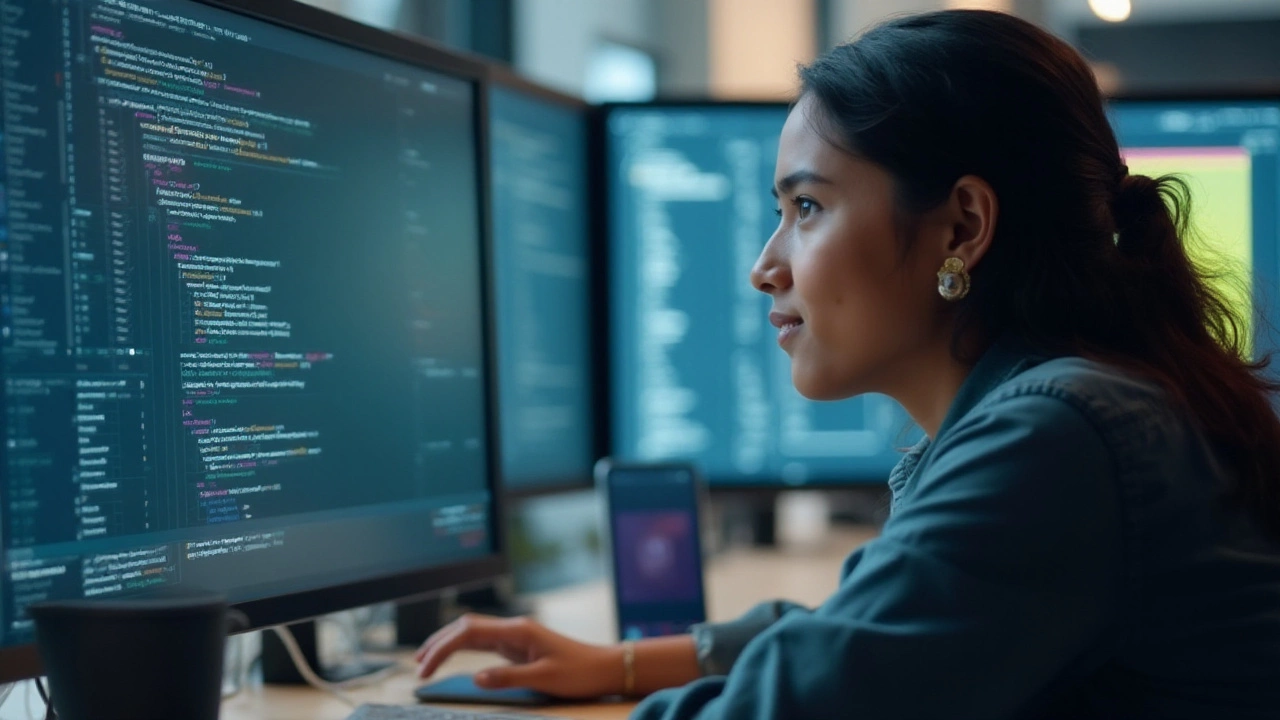
Learning Python is a rewarding endeavor, especially for those eager to dive into the world of programming. Known for its readability and simplicity, Python is a language that welcomes newcomers with open arms. But how long does it take to truly learn it?
Python's learning curve is influenced by several factors. Prior programming experience, the amount of time dedicated each day to learning, and the resources available all play a role in determining how quickly you can pick it up. For complete beginners, it might take anywhere from a few weeks to several months to become comfortable writing basic scripts.
However, Python is not just about syntax; it's about thinking like a programmer. Engaging with practical projects and challenges can accelerate your understanding and make the learning process more enjoyable. Whether through online courses, coding bootcamps, or self-study, the pathway to mastering Python is varied and accessible. Stick with it, and you'll soon find yourself writing Python with confidence and creativity.
- Understanding Python Basics
- Timeframe for Learning Python
- Best Resources for Learning Python
- Practical Tips for Mastering Python
- Common Challenges and How to Overcome Them
- Real-World Applications of Python
Understanding Python Basics
Before diving deep into Python, it's essential to get acquainted with its roots and fundamental principles. Python is often revered for its clean syntax and readability, designed with the philosophy of simplicity and minimalism in mind. Created by Guido van Rossum and first released in 1991, Python's main objective was to bridge the gap between the cost of language learning and the production of effective code. Emphasizing natural language constructs, it allows coders to express their logic clearly, focusing more on solving problems rather than worrying about semantics.
One of the first steps to understanding Python is grasping its dynamic, flexible nature. Unlike usual statically typed languages, Python employs dynamic typing, where the type of a variable is inferred at runtime. This means you can declare a variable without specifying its data type, allowing greater flexibility in writing scripts. This feature not only simplifies the coding process but also enhances the adaptability to changes. In Python, simple concepts such as variables, data types, control structures, and functions form the backbone of basic coding tasks.
Python supports multiple programming paradigms, including procedural, object-oriented, and functional programming, which can be understood more easily by experimenting with small coding challenges. Data structures like lists, dictionaries, and sets are intrinsic to Python and facilitate storing and manipulating data efficiently. A good understanding of these elements can transform how you approach coding challenges, letting you solve problems effectively.
"Computer programming is an art form, like the creation of poetry or music." — Donald Knuth
Getting Hands-On with Python
Installing Python is generally the first practical step in your journey. It can be done easily through Python's official website, where you can download it for free and follow the guided installation process. Once installed, you'll have access to the IDLE, Python's integrated development environment, allowing you to write, test, and debug your code interactively. Starting with small programs like 'Hello, World!' scripts can instill a foundational understanding and boost confidence.
Setting up a conducive coding environment is crucial, and creating virtual environments is a common recommendation among developers. By using tools like venv and pipenv, you can manage dependencies and create isolated spaces for different projects, which facilitates uninterrupted development. As you delve deeper, it's beneficial to explore popular editors like PyCharm or VSCode, which provide numerous features like syntax highlighting and error detection that streamline coding in Python.
Understanding Python's Community and Resources
Finally, becoming part of Python's robust community can greatly enhance your learning process. Engaging with platforms like Stack Overflow, GitHub, and dedicated Python forums can expose you to diverse problem-solving approaches and best practices. Python's extensive library ecosystem is another boon for learners, offering modules that cater to everything from web development to data analysis. Familiarizing yourself with libraries like NumPy, Pandas, and Matplotlib can provide practical insights into handling real-world tasks efficiently.
Embrace the journey of learning Python with an open mindset. As you understand the basics of Python, you lay the groundwork for exploring more advanced topics. The journey is not just about understanding syntax but also about cultivating an ability to think logically and creatively, a skill that transcends coding and impacts problem-solving in various aspects of life.
Timeframe for Learning Python
When it comes to learning a new programming language like Python, one of the first questions that often arises is how long it will take to become proficient. The answer isn't set in stone, as the timeframe largely depends on various factors, such as the learner’s background, dedication, and the complexity of the projects they aim to undertake. Generally speaking, for those starting from scratch, mastering Python to a level where you can comfortably write basic programs could take anywhere from a few weeks to several months. If someone commits to full-time study, dedicating multiple hours each day to intensive programming practice, they could achieve a significant level of proficiency in around 6 to 8 weeks.
However, this time can vary. Those with prior experience in programming might find Python's syntax refreshingly simple and less verbose than other languages like Java or C++. This simplicity can accelerate the learning process, allowing experienced coders to pick up the language in a matter of weeks. On the other hand, beginners who can only commit an hour or two daily might take longer, spanning several months before they feel confident writing intermediate-level scripts. One should also consider that learning isn't just about rote memorization of syntax; it's crucial to understand the underlying logic and problem-solving techniques essential for coding.
Moreover, Python's versatility in various domains like web development, data analysis, and machine learning means that diving deeper into specific areas might extend the learning period. For instance, mastering machine learning algorithms using Python libraries like TensorFlow or PyTorch can take additional time and dedication, especially if one doesn't have a background in statistics or linear algebra. A formal classroom setting or an online course structure with clear deadlines might expedite the learning process, providing a curriculum to follow.
Cory Althoff, the author of 'The Self-Taught Programmer', mentions, "I spent a year and a half working as a software engineer at eBay, but I felt like I still wasn’t a 'real' programmer. A lot of people feel this way about Python, but the truth is, mastery comes with consistency and practical application."
This highlights the idea that while time frames can provide a rough estimate, the real journey to learning Python is a personal one. The practice is just as important as the knowledge itself, encouraging learners to embark on projects, collaborate with others, or even contribute to open-source platforms. By doing so, one can reinforce their understanding and push the boundaries of what they can create with this remarkably powerful language. Setting small, achievable goals, such as completing a basic project or contributing to a community-driven project, can keep motivation high and learning on track.
In conclusion, while there isn’t a one-size-fits-all timeframe for learning Python, setting realistic expectations and immersing oneself in coding can make all the difference. Embracing failure as a part of the learning process and continuing to practice regularly can turn Python learning from a daunting task into a rewarding hobby or career path. Consistency and passion indeed play a crucial role. So, however long it takes, be sure to enjoy the journey.

Best Resources for Learning Python
Embarking on a journey to learn Python can be made smoother by tapping into the wealth of resources available. Whether you're a complete beginner or someone with a bit of coding experience, selecting the right materials can significantly accelerate your learning process. One of the most versatile platforms is Coursera, where courses like 'Python for Everybody' by the University of Michigan introduce programming concepts using user-friendly lectures and practical assignments. This course offers an excellent balance between theory and hands-on practice, making it a favorite among aspiring programmers.
Another stellar resource is Codecademy, renowned for its interactive, on-the-go learning environment. Their Python track is particularly engaging, allowing learners to immediately apply what they've learned in a sandbox environment. This method of learning 'by doing' helps solidify knowledge, reinforcing key Python concepts through repetition and practical application. For those who prefer structured environments, coding bootcamps like General Assembly or Le Wagon provide intensive learning experiences with mentorship from industry professionals.
If self-paced learning is more your style, books like 'Automate the Boring Stuff with Python' by Al Sweigart offer a compelling dive into Python with practical examples. The book is ideal for anyone looking to use Python to solve everyday problems without getting lost in jargon. There are also fantastic YouTube channels such as Corey Schafer’s tutorials, which cover Python basics through to more advanced libraries and applications.
Python's creator, Guido van Rossum, once remarked, "I chose Python as a working title for the language that became Python. It’s been a great success."
Moreover, Reddit's sub-community for Python enthusiasts and Stack Overflow's Python questions section are invaluable for addressing specific questions and learning from a global community of developers. The communal and collaborative spirit found here can quicken your understanding and problem-solving skills. It's essential to supplement these resources with practical projects; websites like Project Euler or even contributing to open-source projects can offer insights and experience that theoretical knowledge alone cannot.
Programming languages, like Python, evolve continually, and staying updated with the latest changes through platforms like Real Python ensures your skills remain relevant. Real Python offers both free articles and a subscription service covering tutorials and code samples. Lastly, for those who enjoy structured challenges, platforms like LeetCode and HackerRank offer Python challenges that push your coding abilities and prepare you for professional Python programming scenarios.
Practical Tips for Mastering Python
Mastering Python is not solely about learning syntax and functions; it's about immersing yourself in a new way of thinking. One effective strategy is to, first and foremost, set clear goals. Ask yourself what you intend to achieve with Python. Whether it’s automating mundane tasks, diving into data analysis, or developing web applications, having a defined purpose can guide your learning path. Once you have clarity on your goals, it becomes easier to find relevant resources and projects that align with your interests and ambitions.
Practice makes perfect, as they say, and this couldn’t be truer when it comes to learning a programming language. Dedicated practice, preferably daily, is essential. You could start with small scripts and then gradually increase the complexity of the problems you tackle. Platforms like LeetCode or HackerRank offer numerous coding challenges that can help reinforce your skills. Consider engaging in pair programming sessions if possible. Collaborating with others can expose you to different techniques and problem-solving approaches, enriching your learning experience beyond solitary study.
Additionally, leveraging the wealth of online resources is crucial. Websites like Codecademy, Coursera, and Stack Overflow are brimming with tutorials, courses, and community support that can help clear doubts and guide you through complex concepts. Reading relevant books, such as 'Automate the Boring Stuff with Python' by Al Sweigart, can offer hands-on experience through practical projects. Another tip is to build a personal project, something that excites you. This could be anything from a simple game to a dynamic website. Personal projects not only solidify your understanding but also make for impressive portfolio pieces.
It is also beneficial to embrace the iterative process of learning Python. Don’t shy away from making mistakes. Each error serves as a stepping stone toward a deeper understanding. Debugging your own code can often teach you more than any tutorial, as it prompts you to think critically and solve problems on the fly. Maintaining a log of your errors and solutions can provide a valuable reference and track your growth over time. You might also want to participate in open-source projects. This experience can give you insights into how large-scale projects are structured and the chance to contribute to meaningful software.
Finally, gaining mastery over Python involves a continual process of learning and application. The field of programming is vast and ever-changing, and staying updated with the latest developments and best practices can keep your skills sharp. Follow industry blogs or subscribe to programming newsletters to remain informed. Remember to celebrate small achievements along the way to keep yourself motivated. As Steve Jobs once said,
“Stay hungry, stay foolish.”This mindset can fuel your passion and perseverance on your Python journey.

Common Challenges and How to Overcome Them
Embarking on the journey to learn Python is exciting, but like any worthwhile pursuit, it has its challenges. Some learners may find themselves struggling with the plethora of concepts, while others might get bogged down by syntax errors or logic puzzles. One significant hurdle that learners encounter is the vastness of Python libraries and frameworks. The overwhelming number of options can lead to confusion about where to start or what to prioritize. It is helpful to begin with the standard library, as it offers a powerful toolset for many basic tasks without requiring third-party modules. As one grows more confident, exploring popular libraries like NumPy for numerical computation or Pandas for data manipulation can expand one's capabilities. These choices often depend on the path you wish to carve, whether it’s web development, data science, or automation.
Managing Errors and Debugging
Another challenge is dealing with errors and bugs, which can be discouraging, especially for beginners. Errors are part and parcel of the programming experience and an essential part of the learning process. To tackle them effectively, it’s important to develop a systematic approach to debugging. Start by reading error messages attentively; they often contain clues about what went wrong. Breaking down code into smaller parts can help isolate the problem, making it easier to identify the source of the error. Utilizing debugging tools available in most Integrated Development Environments (IDEs) can also make the process less daunting. Remember, no coder, however experienced, is immune to bugs: “Debugging is like being the detective in a crime movie where you are also the murderer” - Filipe Fortes.
Staying Motivated and Consistent
Maintaining motivation over an extended period is another hurdle many aspiring programmers face. Coding requires patience, and progress may sometimes feel slow. Setting small, achievable goals can lead to frequent feelings of accomplishment, helping keep enthusiasm high. Joining online communities, attending meetups, or collaborating on open-source projects can provide both support and inspiration. Engaging with others offers new insights and keeps the learning process dynamic. Furthermore, it normalizes the experience of struggling through complex challenges, making it clear that learning Python is a journey, not a sprint.
Understanding Complex Concepts
Concepts like object-oriented programming (OOP) and data structures can initially seem intricate and tough to grasp. Rather than rushing through these topics, it’s crucial to spend adequate time understanding their core principles. Practical application helps immensely; working on projects that specifically require the use of classes, objects, and structured data can make these concepts more tangible. Visual aids like diagrams and flowcharts can also provide clarity. Often, mastering such complexities involves revisiting them multiple times as one’s understanding grows.
While the road to mastering programming in Python can be challenging, each obstacle provides an opportunity to improve critical thinking and problem-solving skills. With persistence and the right resources, it is possible to overcome these challenges, ultimately leading to a rewarding skill set that opens up numerous pathways in the tech world.
Real-World Applications of Python
Python has established itself as a powerhouse in the tech industry, revolutionizing the way applications are developed. One of the key reasons for its popularity is its versatility. In the realm of web development, frameworks like Django and Flask allow developers to quickly build secure and scalable websites. Startups and well-established companies alike rely on Python's simplicity and robustness to bring their web-based ideas to life. This ease of use has democratized web development, making it more accessible to non-traditional developers and hobbyists. Python also plays a crucial role in data science and analysis. With its extensive library ecosystem, including tools like Pandas, NumPy, and Matplotlib, Python enables data scientists to manipulate, analyze, and visualize data efficiently. This is crucial in an era where data-driven decisions are pivotal for business success. Companies like Google and NASA utilize Python to process and interpret their vast datasets, highlighting its capability in handling complex statistical operations and data modeling tasks.
Beyond web development and data science, Python's impact extends into machine learning and artificial intelligence. Libraries such as TensorFlow and PyTorch are foundational tools for building machine learning models, underscoring Python's ability to handle cutting-edge technology with ease. These models power applications that recognize speech, diagnose illnesses, and even predict stock trends. A report by Stack Overflow noted that Python is the fastest-growing major programming language, which is largely attributed to its adoption in AI research. This capacity for innovation has allowed developers and researchers to push the boundaries of what's technologically possible.
The Entertainment and Gaming Industries
The world of entertainment, particularly in animation, also leverages Python. Studios such as Pixar and Disney use Python in the process of movie production scripting, coordinating tasks that automate much of the repetitive animation process. Python facilitates artists to focus more on creative elements rather than technical constraints. Likewise, in the gaming industry, Python is used to create complex algorithms for game logic and to support game design through libraries like Pygame. Python's simplicity allows game designers to prototype and test concepts rapidly, accelerating the game development process significantly.
"Python is our first point of contact with programming, offering a gentle introduction to the world of coding that shapes most of our scripted needs." - Industrial Light & Magic
Furthermore, the finance sector heavily relies on Python due to its reliability and ease of integration with other languages. Python scripts manage crucial tasks such as risk management, pricing analysis, and trade management. Its capability to process large amounts of data quickly makes it a vital tool in the financial analysts' tech stack. As banks and financial institutions move toward more technologically advanced solutions, Python remains at the forefront, driving efficiency and innovation. In many fields, from education to healthcare, Python's practical applications prove its standing as a truly indispensable tool. Educational programs utilize Python as the introductory programming language due to its straightforward syntax and widespread applicability across various industries. Therefore, Python continues to be a cornerstone language in our evolving technological landscape, offering boundless possibilities for those willing to explore its depths. Each of these applications underscores Python's role as a pioneer in programming globally.
